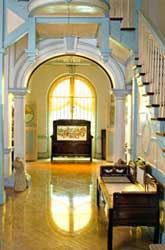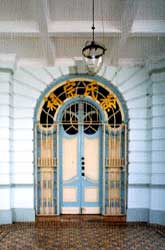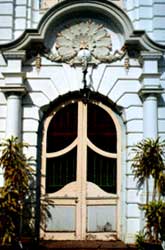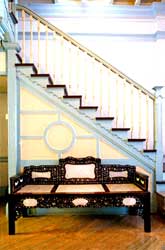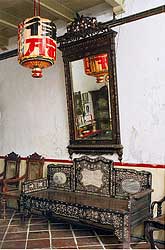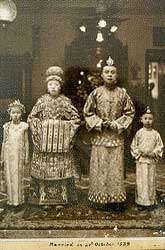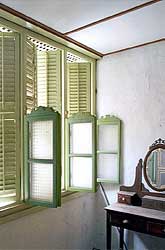Set back from the street with a row of trees lining its approach, the tiered and ornate Chee Mansion serves as a memorial hall for the family.
The entry hall reaches from front to back with rooms opening along both sides.
The arched front doorway is emblazoned with four characters indicating the Chee (Xu) Family Ancestral Hall.
The rear doorway is even more elaborate in style than the front entry.
A blackwood settee with mothers-of-pearl and marble inserts rests alongside the stairwell leading to the floors above.
With a standard placement of doorway and windows that open on to the covered five-foot way, a through-the-wall arched opening connects this residence with that of the adjacent home.
Along one side of the main family room, a blackwood settee with inlaid mother-of-pearl and marble sits beneath an elaborately ornamented framed mirror.
A wedding photograph dated October 24, 1939, with the Peranakan bride and groom plus two young attendants are attired in elaborate costumes appropriate for the first of the twelve days of wedding affair.
The upstairs front bedroom overlooking Jonker Street. Full-length wooden louvers and half-length pressed glass window panes make it possible to regulate both airflow and privacy.
|
|
Chee Yam Chuan was an industrious entrepreneur, his business included trading of rice, flour etc and also into venturing of tin mining industry in the district Lukut district of Southern Selangor in partnership with two Malay Princes, Raja Jumaat and his brother Raja Abdullah (3rd generation of the Sultanate of Selangor).
He was appointed the leader of Hokkien Community in Melaka at a very young age. He was a generous man and donated quite a sum of money to the oldest temple – Cheng Hoon Teng Temple. The surviving Chee Family in Malacca are the 8th, 9th and 10th generation. I am happy to state that the family has contributed its share of social responsibilities to the people of State of Malacca eg. The Eye Clinic at General Hospital Melaka was donated by Chee Swee Cheng, grandson of Chee Yam Chuan, a piece of land at Pringgit for a school which is the present Sekolah Kebangsaan Peringgit.
Chee Swee Cheng, grandson of Chee Yam Chuan distributed food, clothing and ang pows to the poor for many years before his death in 1938. Kings Hotel owned by CYC Hotels Sdn Bhd continues the good deeds of our forefathers and in keeping with the tradition shall donate to Yayasan Toh Puan Zurina for the sum of RM5,000.00.
Chee Mansion
The facades of old buildings along Heeren Street in Malacca generally share a number of common features: white lime-washed two-or three-storey structures, each with a gently sloping shed-like roof over a passageway forming either a private veranda or a five-foot passageway. The ancestral home of Tan Cheng Lock is a fine example of such a terrace house. Punctuating this harmonious succession of townhouse is a fanciful three-storey building that is set back from the street with a watchtower-like pinnacle atop it. While often called the Chee Mansion, the four characters across the doorway today proclaim that it is the Chee Family Ancestral Hal, commemorating a lineage whose ancestor, Chee Soo Sum, arrived in Malacca in the second half of the eighteenth century from Zhangzhou in China’s Fujian province.
Ancestral halls of this type called by Peranakan rumah abu, a loan word from Malay. On the front gate there is four-letter monogram, CYCT, set within concentric circles, standing for “Chee Yam Chuan Temple”. These initials highlight the fact that the shrine does not reach back to the kaijizu or focal (founding) ancestor of the Chee lineage, Chee Soo Sum, but instead to his great-grandson, Chee Yam Chuan, the most notable forebear in the lineage.
Chee Yam Chuan (Xu Yanquan) was born in Malacca in 1819 and died tragically in 1862 from an assassin’s bullet at a wedding dinner in Malacca (Hamidah ,2000). During his short life, he became, at twenty-one, the head of the Hokkien huiguan in Malacca and amassed a substantial fortune from investments in the economic development of Malaya. Since the Hokkien huiguan was a veritable Chamber of Commerce of Malacca’s business interests, Chee Yam Chuan was, in effect, the leader of the community of all immigrants and their descendants from Fujian. His rise to such a position may have come about because of the death of his father the year before, in 1839, who himself was an important merchant and civic leader in Malacca. Known as a planter of nutmeg in both Malacca and Singapore, Chee Yam Chuan amassed sufficient resources to advance capital for investment in the tin mining industry in the Lukut district of southern Selangor. He was noted for the partnership he had with two Malay princes, Raja Juma’at and his brother Raja Abdullah, loaning them substantial sums in return for shares of profits in their tin mining ventures. A further indication of their mutual trust was that Raja Juma’at’s son moved to Malacca to live with Chee Yam Chuan in order to facilitate contact with other Malays eager to solicit from Chinese merchants. His successful at amassing investment capital contributed, some historians believe, to quickening the clearing of the jungle and the development of Kuala Lumpur as a prosperous town (Andaya and Andaya, 1982:139). In 1848 Chee Yam Chuan and several other prominent businessmen figured prominently in the restoration of the Cheng Hoon Teng Temples, the oldest Chinese temple in Malaysia, which dates from 1645.
Chee Yam Chuan had ten sons and an unknown number of daughters, whose families have flourished, increasing significantly over the next six generation to the present. His grandson Chee Swee Cheng together with Chee Yam Chuan’s sons Chee Lom Bong and Chee Quee Bong, all of whom were successful businessmen in Singapore, conceived the idea of building an ancestral home in 1906 to venerate Chee Yam Chuan. This was a time, of a resurgence of Chinese culturalism, a renaissance of an awareness of Chinese values such as filial piety, especially among those educated in Western schools who considered themselves worldly and cosmopolitan. It was in this context that an extravagantly Western-style building was built to venerate a Chinese forebear, creating a place for an ancestral altar for the tablets of successive generations of Chees. Furnished with chairs, tables, cabinets, screens, and ornaments imported from China, this grand building declared that the Chee family gained strength from a fusion of their Chinese and European heritages. From time to time over the years, Chee family members have lived in the house, most recently during the renovation of a neighboring terrace house, but the expressed function of this opulent structure was to acknowledge their ancestor with regular offerings and to assert their broader familial ties by gathering at Chinese New Year and at other significant occasions.
Set back from the street with garden and parking area in front as well as behind, the building sits on a 1022-square meter plot of land with traditional, but modernized, terrace house abutting it. Whether viewed from the outside or the inside, the lines, textures, and scales articulate the refined hands of a skilled architect and the craftsmanship of many trades. The building, a neoclassic blend of Dutch, Portuguese, Chinese, and English styles, was designed by a Malacca Dutch-Eurasian architect from the Westerhout family, who trace their roots in Malacca to the eighteenth century. It is said that the floor tiles and colored glass for the doors and windows were imported from France and Italy. Highly qualified artisans were employed for the construction and finish work.
Just inside the arch-shaped front doorway, which opens from a covered porch, is an entry hall with marble floors. Ahead through an arch is a well-proportioned colored glass window that bathes the entryway with bright light. Two large rooms are off to the left and right, one with a long dining table with seating capacity foe at least a dozen people and the other a sitting room with Chinese furnishings. In addition to a framed diagram listing all the male descendants for the five generations after Chee Yam Chuan, as well as his father, grandfathers, and great-grandfather, are many family photographs on the walls. In the back portion of the entry hall, tucked in a corner and set on a pedestal is a large iron safe made by a Chinese firm with offices in Penang and Singapore to safely store the family’s treasures. The kitchen and quarters for servants are located in the back of the building. After exiting a rear door and passing parked cars, it is impressive to see that the rear elevation is also characterized by elaborate architectural and ornamental details.
A prominent element of the house is the intricate and complex set of stairs with rosewood treads that reaches from the ground floor upwards to the domed cupola soaring above. In effect, the staircase and landings create an open central atrium that extends the full height of the building. Several large, but now vacant, rooms are found on both the second and third floors.
The Chee family ancestral altar is located on the mezzanine floor between the ground and second floor, with tablets arrayed on tiers representing at least four generations.
The Chee family created the Chee Yam Chuan Temple Trust to fund and manage the maintenance of this historic structure as well as the burial sites of family members. According to a news report quoting Chee Swee Hoon, the Executive Chairman of the Trust, :the Trustees are also planning to set up a company with the aim of sharing the benefits with the Chee descendents, by way of offering them shares and dividends” (Wee,1999). The public, while viewing the magnificence of its expansive outer courtyard, ornate façade, and towering spire, must come to realize that this imposing structure embodies more than what merely appears on the outside. The building is an expression of the Chee family’s identity, which straddles both the Chinese and Western worlds, transforming what some might see as only an abstract concept of intergenerational relationship into a material form.
Chee Jin Siew Home
The facades of townhouse lining both sides of Heeren Street remain a gallery of Malacca’s early twentieth-century elite. Parallel Jonker Street, on other hand, once known for its mixed uses – gilded clan halls, a school and a theater, and an array of shophouses selling traditional as well as many modern goods – has undergone a metamorphosis. Today, many of the old structures are gone and replaced by venues such as café, pubs, and souvenir shops catering to the mass of tourists who flock Jonker Walk, a rebranded nightmare bazaar launched by the city government. “Since 2000 Jonker Street has reeled under repeated assault: the depletion of a traditional resident community, in which the Straits Chinese are now reduced to a single family; the eviction of established trades and the demolition of their premises; the decay of heritage structures amid new campaigns designed to lure the indiscriminate tourists; the encouragement of more outlets peddling kitsch that already bristles along the road; and the sanctioning of yet more projects that misrepresent the street’s historic fabric. All have cost Jonker Street its soul” (Lim and Jorge. 2005: 08). Indeed, many who are concerned with the authentic representation of Malacca’s heritage have been saddened by this makeover. It is somewhat ironic that the English translation for Jonkerstreet, the original Dutch name for Jonker Street, is Nobleman’s Street.
Yet, even with these coarse transformations, some residents have been able to maintain their old homes in a fashion that would be recognizable to a returning visitor from early twentieth century. One home that is especially notable is the Chee residence at No, 9 Jonker Street, not too far from the river, which is one of traditional residences whose skywell voids and rooflines are clearly seen today in satellite images. The residence is owned by a branch of the family whose patriarch. While it is not possible to date the initial construction of this residence, it is certain that Chee Jin Siew, a son of Chee Yam Chuan, lived there until his death in 1881. Over the span of the following five generations, including the young children living there today, the family made a variety of renovations to accom-modate the changing expectations of modern life, but the residence still preserves significant aspects of its original plan, furnishings, and ornamentation. Today, the home is occupied by the small nuclear family of Chee Gim Chye, the great-grandson of Chee Jin Siew.
To passersby who take only a quick look, the late nineteenth-century façade appears somewhat unremarkable and pedestrian, combining a traditional lower portion with an updated set of rectangular windows above. Closer inspection reveals the through-the-wall arch of the original five-foot way, a classic set of doors and windows, and a booklet of Chinese phrases ornamenting the surfaces. Above the door are the two characters ruixing, an invocation meaning “May That Which Is Propitious Flourish.” This idea is amplified by appearing in a set of two-character phrases, ruiqi and xinglong. On the door panels with the combined meaning of “May the Propitious vapors Flourish.” Similar auspicious phrases appear on the folding panels of the window shutters. Painting of birds and flowers within lobate forms above the windows proclaim mingshan and xiushu, “ Bright mountains, beautiful Waters,” a common phrase used in fengshui to indicate not only beautiful scenery but also a favorable site. Since the theft of antique furnishings continues to be a perennial problem in Malacca, the presence of a folding iron gate and secure locks are prudent additions to old homes like this one.
The main hall, as is the case with others illustrated in this book, is furnished with handsome blackwood furniture with marble inserts, carved in styles common in the waning years of the Qing dynasty. Featured prominently above the altar is a painting of the venerated deity and folk hero Guan Gong, esteemed as a symbol of righteousness and loyalty. Above the doorways leading to the next room are the four characters nanzhou donghai, with obscure metaphorical meanings. The traditional paper lamps seen in this hall, which normally would be hung outside, are out of place since they reference the goodness Mazu and her tianhou temple rather than the Chee family. A small sitting room is located behind the main hall with a central passageway into yet another large room. A notable feature of this small room are the molded glass window panels with a design that includes a flowering prunus, indicating “happiness”, among pineapples, which in Hokkien are called onglai, said to be roughly homophonous with characters meaning “ the arrival of good luck”. (Welch, 2008:57)
The next room, which continues the old glazed tile flooring of the front hall, is also furnished with sumptuous furnishings, some of which are inlaid with mother-of-pearl. Other pieces, including hanging mirrors and multitiered cabinets, are typical of Peranakan furniture of the late nineteenth and early twentieth centuries. Known as “brown-and-gold” furniture are made in Malaysia and Singapore, each is characterized by ornately carved designs and ornamentations that are not only clearly Western in inspiration but also detailed flourishes that are Chinese. One of these tiered cabinets, with its elaborate crown, is set as if it were an ancestral altar. A photograph of the grandfather of the current owner, Chee Eng Cheng, who died in 1916, has before it a single ancestral tablet as well as incense and candles in addition to fresh fruit and small cups that tell us that the family still venerates this ancestor on a regular basis. Pictures of other Chee family members are arrayed on the walls flanking this “altar”. Some of the old photographs of weddings in the 1930s, with the bride and groom dressed in Peranakan finery, were taken in front of this multitiered cabinet at a different location in the room. A pair of glass-faced cupboards with a carved arched top is recessed into the facing walls. The hanging lanterns in this room are elegant, painted not only with characters indicating this is the Chee home but also their expressive symbolic name ruixing, which was seen above the entryway to the residence.
In the kitchen towards the back of the house, adjacent to the skywell, is a shelf with a tablet representing the Stove God with four characters kitchen area is a curious configuration in which a narrow passageway juts off perpendicular to the main axis of the house, leading to a gated back entryway on First Cross Street, the rear of the Chee dwelling abuts up against the restored eighteenth-century shophouse at No. 8 Heeren Street.
An elegant curved stairway sweeps up to the second level where the age of the building becomes more apparent because of weathering of the wooden flooring and painted walls. Here are found bedrooms and passageways, some of which are currently used by family members and others used to store old furniture, the walls and tables are replete with family memorabilia. Two features of the wooden floor are especially noteworthy. Under the carpets in some rooms, floorboards can be removed to open up storage space beneath, said to have been a place to store family valuables during the Japanese occupation of Malaya. In the front bedroom, which is directly above the front hall below, a square block of wood can be removed to open up a peephole for women to see who is being received below. From the upstairs verandas it is possible to catch glimpses of the distinctively Chinese ridgelines and gables of nearby residences and some of the physical linkages between them.
While this nineteenth-century Chee residence retains the essential character of the times when it was built, there also is evidence of the corrosive effects of Malaysia’s hot and humid climate on old buildings. Mildewed walls, flaking plaster, rotting wood, deteriorating paper, and fading photographs all present intrusive challenges to owners of old homes. The maintaining of an ancestral home involves not only a sense of history and determination but also the necessity to expend substantial amounts of money and time in the endeavor. Private owners of historic homes bequeathed to them, such as Chee Gim Chye, work quietly and usually without governmental assistance. They deserve not only acknowledgment for their heroic efforts but also the support of the broader community. |


